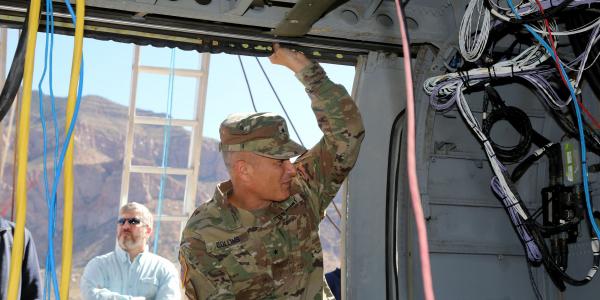The Army's Tactical Network Must Support Intelligence and Electronic Warfare
The ability to provide deep sensing for long-range fires, confront IEDs, increase the survivability of aircraft, and conduct ISR hinges on an advanced tactical network on the battlefield.
The ability to provide deep sensing for long-range fires, confront improvised explosive devices, increase the survivability of aircraft, protect forces, and conduct intelligence, surveillance and reconnaissance, all hinges on an advanced tactical network on the battlefield.
As the U.S. Army pursues its Integrated Tactical Network (ITN) concept, Brig. Gen. Robert Collins, USA, program executive officer (PEO) Intelligence, Electronic Warfare and Sensors (IEW&S), is making sure that the components of the ITN reflect intelligence, surveillance and reconnaissance (ISR); electronic warfare; and sensor needs. He is working closely with the Network Cross-Functional Team (CFT), which is charged with modernizing the Army’s digital platform.
“We directly map to the Network CFT because all of our intelligence has to seamlessly ride over the network,” Gen. Collins says.
And although there is not a specific ISR CFT, ISR components run across several of the Army’s eight teams that are implementing the service’s six modernization priorities under the guidance of the Futures Command. As such, the PEO is engaging with the Position, Navigation and Timing (PNT) CFT; the Long-Range Precision Fires CFT; and the Next Generation Command Vehicle CFT—in addition to the Network CFT, PEO Command Control Communications-Tactical, known as PEO C3T, and Futures Command leaders.
“We work very closely with the Futures Command, and they’ve done a phenomenal job establishing concepts of operations, prioritizing science and technology, and helping us with the requirements process so when it comes into the acquisition community, we’re prepared to deliver quickly,” the general states.
The PEO IEW&S plays a key role in developing and integrating the systems that support sensors and sensor data to provide a comprehensive understanding of the battlefield. That sensor information goes to warfighters who are performing intelligence, electronic warfare, situational awareness, force protection, reconnaissance, surveillance and target acquisition, among other vital activities. The PEO provides the kit or necessary equipment for ISR activities as well as offensive and defensive electronic warfare—solutions for which the Army is currently upgrading (See page 21).
The PEO also provides IEW&S capabilities and readiness support to more than 140,000 soldiers currently deployed worldwide.
To enable intelligence, electronic warfare and sensor performance, the latest set of capabilities to the ITN, Capability Set 23 (CS 23) must provide network resiliency, integrate more commercial information technology and satellite capabilities, and enhance data management, Gen. Collins states.
“It is all about the data,” the general declares. “And we’ve got to make sure that we’ve got open, standards-based, discoverable data that we can exchange between what we do in an intel and sensor environment, across the network, and then inform the folks that make decisions in the battlespace for mission command. We’re working with the Network CFT on how we get after cleansing the data and making sure that it can be commonly shared.”
As the leaders work to consolidate the data, they also are tackling how to present “a common look and feel” of displaying information to warfighters. “Regardless of what functional area you are in, whether it is in intelligence or mission command, you have the Command Post Computing Environment with a kind of a common look and feel,” he explains. “We all just simply provide apps into a common environment. That’s been a big area that we’ve worked on with the Network CFT, and there is a tight synergy between ops [operations] and intel, and how we converge that information.”
For warfighters, the general needs the ITN to offer additional resources, given increasing spectrum and network demands. “I would tell you too that with spectrum, network and bandwidth, it is a finite resource to be able to move data and information,” Gen. Collins observes. And because intelligence operations center around gathering large amounts of data, any tactical network has to support those loads. “We collect geospatial data, we collect full-motion video,” he notes. “We collect fairly intensive amounts of data, and so how do we more smartly move that data, across the network.”
In addition, the PEO IEW&S supports intelligence operations across different security classifications, the flexibility of which needs to be incorporated into the network design, Gen. Collins adds.
PNT from a network perspective is “another big area” that the PEO is addressing—with the help of the PNT CFT—including how to potentially calibrate encryption. “That CFT is as much about navigating from point A to point B to making sure that we’ve got timing,” the general shares. “Everything in this advanced Army works on timing.”
With the Long-Range Precision Fires CFT, PEO IEW&S is looking into various space-based resources, while with the Next-Generation Combat Vehicle CFT, they are incorporating advanced infrared sensors.
Gen. Collins also shares that he will continue to focus on the four organizational priorities he outlined when taking on the role of leading PEO IEW&S almost a year ago: (1) people, and emphasizing leader talent management and workforce support; (2) sensor advancement; (3) improving acquisition to make it more agile and responsive; and (4) engaging stakeholders.
“I’ve got a fairly diverse portfolio of sensors, and as you start talking about some of the new concepts that the Army is pursuing, sensors are ubiquitous on the battlefield,” he states. “And so, advancing how we integrate those sensors to improve our intelligence and Mission Command capabilities [is key].”
The PEO will continue to watch emerging technologies, such as artificial intelligence and machine learning, which can help the military’s intelligence efforts. “It is not about replacing a soldier,” he says. “We want to use artificial intelligence to tip and cue early and help speed the decision cycle as time itself becomes a weapon.”





Comments